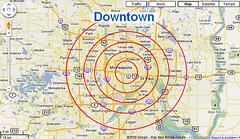 Google disclosed their three primary types of signals for local search rankings this past month in a blog post on LatLong. In it, they flat out stated that these are: Relevance, Prominence and Distance.
Google disclosed their three primary types of signals for local search rankings this past month in a blog post on LatLong. In it, they flat out stated that these are: Relevance, Prominence and Distance.
For those who’ve been following our articles and conference presentations for the past few years, none of these broad categories of signals come as any sort of a surprise.
Although Google LatLong declares in their post’s title that it’s about “How Local Search Ranking Works”, they’re still understandably obscure for the most part, and avoid providing all that many specifics. There’s a natural tension between informing businesses on how to provide Google with ideal information necessary for ranking, and providing so much info that search engine optimization specialists have “undue advantage” (from Google’s perspective).
So, I thought I’d take this opportunity to list out a number of more specific factors which could feed into Relevance, Prominence and Distance. Read on for a refresher on local search ranking factors which likely could contribute to each of these.
RELEVANCE
- Business Name matches the user’s search keyword phrase;
- Business Category (in Google Places) matches the user’s search keyword phrase;
- Business Description or additional data fields match the user’s search query;
- Keywords found on the Business’s website match the user’s search query;
- Keywords on the Business’s website and Google Places fields indicate a match for the user’s search location;
- Description text for the videos and images related to the Business include keyword phrases which match the user’s search query;
- Business Categories may be mapped to match related Categories. For instance, if the user seeks “Restaurants”, but you’re only listed as a “Cafe”, then Google would likely choose to display your listing due to thesaurus relativity.
- Fuzzy matching algorithms can also come into play for Relevance. For instance, common misspellings may be matched between the user’s queries and contents of your listing, website, and other data sources about your business.
- Keyword relevance also comes into play with all of the various data sources which Google associates with your listing. For instance, keywords found in your internet yellow pages listings, newspaper articles about you, and places where people mention your business — all of these could be matched up with the search keywords users supply when searching for local businesses.
- It should be noted that it’s likely that information on your website and directly in your Google Place page may be deemed to be more important and therefore more heavily-weighted in relevancy considerations than information on less-central pages such as internet yellow pages, articles, etc. However, having some level of keyword consistency among all the resources citing your business listing could additively help your overall relevancy scoring.
PROMINENCE
- Prominence would be composed of signals which could help Google assess your company’s overall popularity compared with other similar businesses. Google’s classic ranking assessment is therefore also one of their prime signals for local rankings: PageRank. PageRank involves the number of webpages linking to a webpage or website, and the relative importance of each of the pages which are linking.
- Citations are the new link where local search results are concerned, so having webpages that mention your company name, address, and phone number could help to build up your signal weight for relative popularity.
- Your business’s location itself may independently have prominence signals associated with it, somewhat independent of the reputation of your business itself, and this could theoretically influence your rankings. For instance, a Chinese Restaurant tucked away on an off-street in a residential neighborhood might be assessed as less-popular than an otherwise similar Chinese Restaurant which happens to be located next door to a major tourist destination. While this may sound like a proximity signal, it’s really more about the relative popularity of places themselves which then may apply to a local business or organization. So, if your company is located next to a place which merits an article in Wikipedia, or in a highly-trafficed neighborhood, or next to a popular amusement park, you may reap the benefit of the popularity coming off of it.
- Reviews and Ratings are an obvious indicator of popularity and quality, although they’re so obvious that Google has long stated that rating values themselves are not used for ranking purposes. However, there still appears to be some association between highly-rated/reviewed companies and rankings. It’s unclear if this is cause or effect, however, since the most-popular businesses (as assessed through other signals) are also often those which have the best ratings. Further, Google’s recent algorithmic tweaks in the wake of the “Decor My Eyes” story may now be incorporating some review sentiment analysis in determining negative ranking criteria — possibly using such info to penalize rankings of bad companies, while not really using them to influence positive rankings.
- Consumer Click-Throughs to a business from Google search results has been a controversial/theoretical factor among search marketing experts, although Google patent filings document this as a potential metric which could be used for assessing relative popularity/importance. Under this concept, if your business listing info were clicked-upon or otherwise interacted-with more than that of similar competitors appearing in the same SERPs, you could get a ranking boost.
- Social Media signals are likely to be an increasing Prominence factor. Social media interactions are already influencing real-time search as well as personalized search, and I’d bet they may be influencing even more than what the search engines have openly disclosed. For instance, the number of Facebook “likes” of a business and its associated pages should be a valuable signal to search engines. Increasingly, assessments of importance of social media mentions will also rely upon the relative importance/prominence of the person/account posting the mention.
DISTANCE
- Distance has been one of Google Maps prime local ranking signals since inception — so much so that I once jokingly suggested businesses might move locations in order to rank better. It used to be that businesses which were located closest to city centroids had a major advantage over businesses located further out from city centers. Over time, Google has adjusted the weighting of the various ranking factors so that proximity doesn’t have quite the overly-heavy influence it once did, but it still factors in. So, the main element of this has been the relative radial distance from city centroids. There really isn’t much one can do to alter your location, so the classic old business advice still remains valid in this respect: “Location, location, location.”
- Google has altered some from dependence upon the city centroids, however, and now they are factoring-in the outlines of cities, ZIP code region outlines, or using something like heat maps of population densities in order to figure out location associations according to geographic position.
- For businesses desiring to have a good Distance signal, there is overlap between this and Relevancy signals. It’s important to mention your location’s city name, neighborhood name, as well as various other location nicknames that people may be using to search for businesses in your area. For instance, many denizens of Manhattan use the abbreviation “NYC” when searching online.
- Finally, many service-based businesses provide work in major metro areas beyond the borders of the smaller city region where their listing is physically located. For instance, a Plumber located in Orange, California, might offer services to numerous cities in the greater Los Angeles region. For these types of businesses, it’s very important to mention the names of each of the cities where they offer service — mentioning the names on their Google Place page, website, and other citation sources.
- Downtown searches may still be one special case where centroid distance is particularly influential.
For more information, also be sure to read my “Local SEO Primer” on how to rank in Google Place Search Results.










Thanks for your post, I know many small business owners who struggle with Google local listings and your article was really helpful, especially explaining citations as links.
Very comprehensive Chris, and great information. Thanks!
Does header info like latitude and longitude help too? If the reviews section of your site is heavily visited it does give some prominence